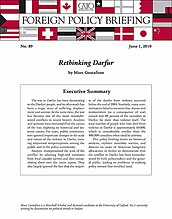The war in Darfur has been devastating to the Darfuri people, and its aftermath has been a tragic story of suffering, displacement and sorrow. At the same time, the war has become one of the most misunderstood conflicts in recent history. Analysts and activists have oversimplified the causes of the war, slighting its historical and systemic causes. For years, public commentators ignored important changes in the scale and nature of the violence in Darfur, causing important misperceptions among the public and in the policy community.
Analysts misrepresented the scale of the conflict by selecting high-end estimates from local casualty surveys and then extrapolating them over the entire region. They also largely ignored the fact that the majority of the deaths from violence occurred before the end of 2004. Similarly, many commentators failed to mention that disease and malnutrition (as a consequence of war) caused over 80 percent of the casualties in Darfur, far more than violence itself. The total number of people who have died from violence in Darfur is approximately 60,000, which is considerably smaller than the 400,000 casualties often cited by activists.
This policy briefing draws on historical analysis, explores mortality surveys, and dissects six years of American budgetary allocations in Sudan to demonstrate that the conflict in Darfur has been misunderstood by both policymakers and the general public, leading to problems in crafting policy toward that troubled land.

This work is licensed under a Creative Commons Attribution-NonCommercial-ShareAlike 4.0 International License.
